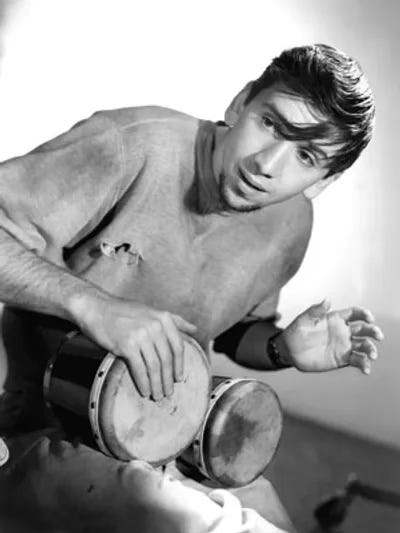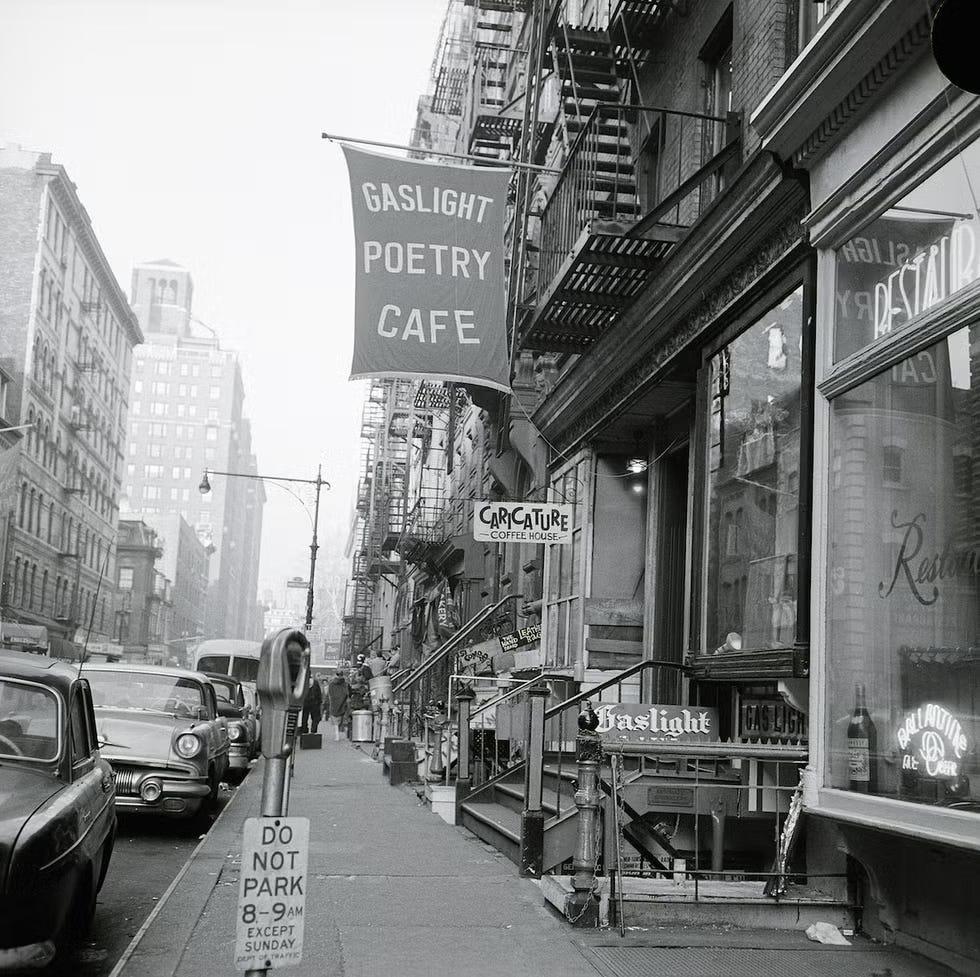From the Beats to the Hippies: How a Generation of Rebels Birthed a Revolution
Or How the Beatniks Set the World on Fire and Watched It Burn
Picture this: It’s 1961 in Greenwich Village, and you’re hopping from a dimly lit poetry reading at The Gaslight to a smoky corner of Café Wha? where Lenny Bruce is tearing into a savage rant about his latest obscenity arrest. You grab a coffee, chain-smoke your way to the Village Vanguard, and let John Coltrane scramble your mind with a saxophone solo that triggers an out-of-body experience. Then it’s off to a tiny walk-up apartment where you and your fellow night creatures discuss Kerouac and Sartre until dawn, passing around a cheap bottle of Chianti in holy communion.
This is the Village, the last bastion of the Beatnik dream—a world of jazz, poetry, and cheap rent, where the rules don’t apply and the squares are too afraid to step inside. But soon, this whole scene will be gone—swallowed by commercialism, mocked by the mainstream, and replaced by a generation that thinks LSD is the answer to life’s mysteries.
The Beatniks were chasing something—truth, freedom, a way to exist outside the antiseptic nightmare of post-war America. They found it in jazz, poetry, and long, rambling road trips that never really ended. But the same system they were rebelling against was always one step behind, waiting to co-opt, commodify, and neuter the movement until it was nothing more than a joke—a Halloween costume with a beret and a pair of dark sunglasses.
The Prophets of the Beat Gospel
The Beat Generation wasn’t just a literary movement—it was a way of being. Jack Kerouac, Allen Ginsberg, William S. Burroughs—these were the prophets of a new gospel, their words scrawled onto endless scrolls of paper, spilling out in frantic, unedited bursts of spontaneous prose.
Kerouac’s On the Road didn’t just tell a story; it created a mythology. Neal Cassady, the real-life inspiration for Dean Moriarty, became an archetype—the reckless, jazz-infused spirit of the open highway, burning through life at 100 miles per hour.
But every mythology has its dark side. Lucien Carr, a central figure in the early Beat scene, killed a man and dumped his body in the Hudson River. William Burroughs, high on heroin and detached from reality, shot his wife in the forehead in a drunken game of “William Tell” gone wrong.
The Beats lived hard, wrote hard, and often died young—Kerouac himself drinking himself into oblivion by 1969, just as the last traces of beatnik authenticity were being wiped away by the flower children.
The Jazz Connection: The Soundtrack of the Beats
Jazz was the heartbeat of the movement—bebop pioneers like Charlie Parker and Thelonious Monk provided the improvisational spirit that fueled the Beats’ freewheeling, unscripted philosophy. They snapped their fingers in basement cafés, worshiped at the altar of the saxophone, and believed in poetry that didn’t just sit on the page but lived and breathed.
But then it all went wrong. The jazz clubs and coffeehouses turned into tourist attractions. The term beatnik—originally a slur, a sneering media invention—became a brand. Hollywood made movies about phony beatniks in turtlenecks and bongos. The revolution had been repackaged, sanitized, and sold back to the masses.

The Beat Generation’s Last Gasp and the Rise of the Hippies
The Beats didn’t just vanish—they mutated. Their movement, their language, their philosophy were absorbed by the counterculture that followed. If the Beats were the spark, the hippies were the inferno.
Ginsberg embraced the hippie movement, standing onstage at anti-war rallies, chanting Buddhist mantras, and preaching the psychedelic gospel to thousands of kids tripping on acid. The countercultural ideals of the 1960s—rejection of materialism, spiritual exploration, free love, and anti-war sentiment—were all lifted straight from the Beat ethos.
It was no accident that Ken Kesey and his Merry Pranksters idolized Neal Cassady, the same restless drifter who once drove Kerouac across America. By the mid-’60s, Cassady had traded in his freight-hopping ways for a psychedelic-painted school bus, guiding the next generation through acid trips rather than jazz clubs.
The Beats had sought spiritual enlightenment through Zen and poetry; the hippies sought it through LSD and rock festivals. Where the Beats roamed America in search of meaning, the hippies gathered in communes, trying to build their own version of paradise.
But Kerouac wanted nothing to do with it. He hated the hippies. He saw them as phonies, cheap knock-offs of the Beat lifestyle without any of the literary ambition or spiritual depth. “They’re ruining everything,” he grumbled in drunken interviews. He watched from the sidelines as Ginsberg became a countercultural icon, while he himself became a relic of a bygone era—just another washed-up writer ranting about the kids these days.
The Beat Generation’s Legacy on American Culture
The Beat Generation may have burned out, but its fingerprints are everywhere. Every counterculture that followed—from the hippies of the ’60s to the punks of the ’70s, the grunge kids of the ’90s, and even today’s restless digital nomads—owes a debt to the Beats.
Their language seeped into our lexicon—cool cats, dig it, square—all borrowed from the jazz clubs they idolized. Their defiance paved the way for every outsider, every artist, every restless soul who refused to conform. They helped break the chains of censorship—Howl and Naked Lunch were both put on trial for obscenity and won, making it possible for future writers to push boundaries.
Bob Dylan, The Beatles, The Doors—hell, half of rock ‘n’ roll’s most poetic lyricists—read On the Road or Howl and found themselves changed. Even Hollywood cashed in, turning Kerouac’s road novel into a template for countless films about aimless young rebels looking for meaning. The 60s tv show, Route 66, was a sanitized version of Kerouac’s book.
And now? The world is still full of beatnik ghosts. They live in the tattooed poets scribbling in cafés, in the road-trippers who ditch their jobs to chase some hazy American dream. Every time someone hears Coltrane wailing and feels something shift inside them, the spirit of the Beats flickers back to life.
Maybe the Beats Were Always Doomed—Or Maybe They Won
Maybe the Beat Generation was never meant to last. Maybe their ideals could never survive in a world built on structure, order, and consumption. Maybe Kerouac, Ginsberg, and Burroughs were just a fleeting moment, a beautiful mistake, a brief explosion of creative energy that had to burn out.
Or maybe they won after all—because every time someone throws their belongings in a car and drives west with no real destination, every time someone sits in a café scribbling poetry into a tattered notebook, every time someone chooses art over money, freedom over security, passion over practicality—the spirit of the Beats lives on.
Village Sunday, 1960, narrated by Jean Shepherd
Next time:
Until we meet again, please let your conscience be your guide.








The Beatniks and Hippies formed close personal bonds in person, thus forming communities with definable identities. Are today's youthful populations too self-absorbed and consumed by Social Media and cell phones to create such a movement in real time?
your last paragraph describes what became my mantra leaving michigan in 1970 at 17 and beginning a life of experiences and adventures, not all good but no regrets, other than what anyone who is lucky enough to live long enough has. really loved the article, mahalo